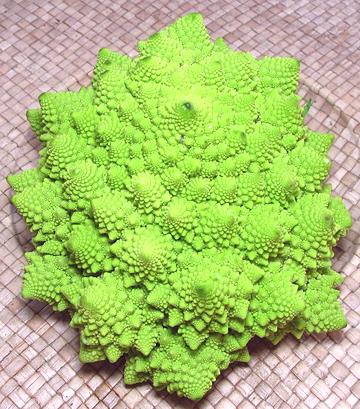 [Fractal Broccoli; Chou Romanesco (French); Broccolo romanesco,
Cavolo romanesco (Italian); Pyramidenblumenkohl(German);
Brassica oleracea Group Botrytis]
[Fractal Broccoli; Chou Romanesco (French); Broccolo romanesco,
Cavolo romanesco (Italian); Pyramidenblumenkohl(German);
Brassica oleracea Group Botrytis]
This flowering cabbage is a stunning example of how nature encodes large amounts of genetic information in a mathematical form called fractals. The head is a cone, made up of spirals of smaller but otherwise identical spiral cones, which are in turn made up of smaller spiral cones, ad infinitum. Actually all cauliflowers are built pretty much this way, it just isn't so clear and orderly.
Although first reported from Italy in the 16th century, acceptance of this variety has been held back by a fierce dispute as to whether it is a broccoli or a cauliflower. The ISHS (International Society for Horticultural Science) has published a study which states, "Multivariate analyses are presented which support the view that cultivars grouped within the form Purple Cauliflower should be placed in the same botanical variety as Broccoli/Calabrese (var. italica) and those of Romanesco with Cauliflower (var. botrytis)". So there, now you can eat it - but take care, it reacts very poorly to over-cooking. Steam until just tender.
More on Cabbage Flowers.
Romanesco is smaller, lighter in density, more tender and faster cooking than regular Cauliflower. The flavor is quite mild and a little more broccoli-like. It is best to serve it as whole florets, both for visual effect and so the pieces are large enough that the flavor can be easily appreciated. It is also fine eaten raw in salads and the like.
Select heads that are fresh looking and not badly bruised. If there are leaves they should look fresh. Unfortunately, heads are often handled roughly, and the points of the cones are bruised. For the price they're sold at they should be given special care to avoid this.
Heads that are fresh and in good condition can be kept in the refrigerator, loosely wrapped in plastic and protected from bruising, for a week or so.
Because of the difference in cooking time between stems and flowers, it's best, when dividing into florets, to split the stems lengthwise, in half for small stems, quarters for larger. Florets should be steamed for about 9 minutes, a whole head a bit longer. If you cook in boiling salted water the time will be shorter.